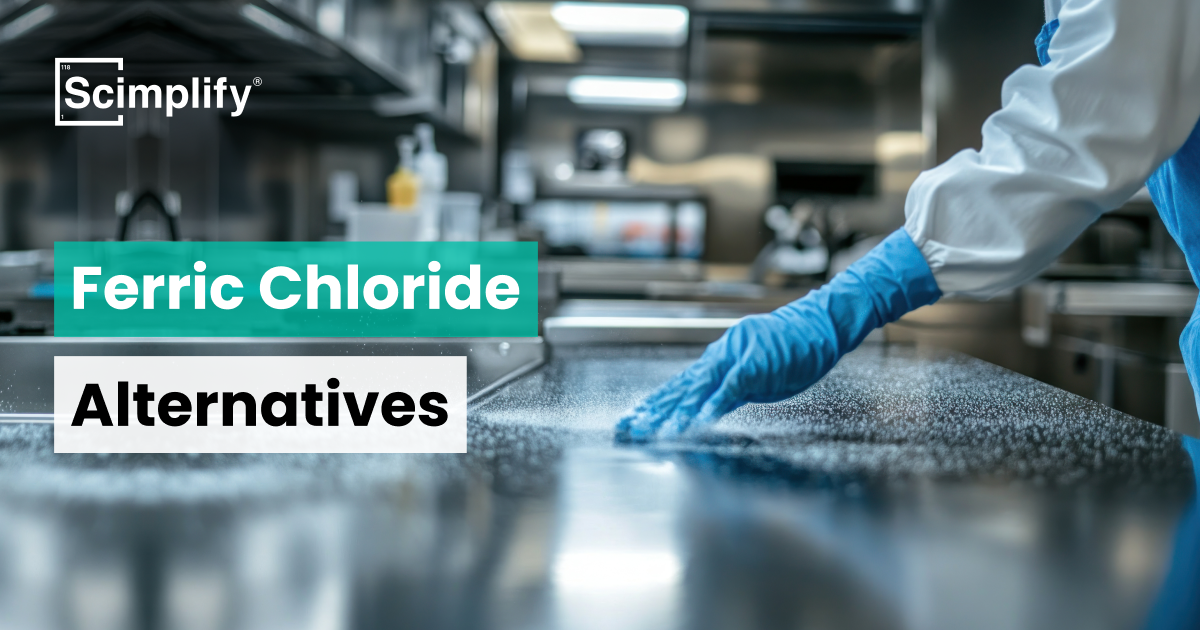Ferric Chloride - Alternatives, Pros and Cons
Ferric Chloride (FeCl₃) is a powerful coagulant, oxidizing agent, and Lewis acid used in water treatment, electronics, pigments, and catalysis. Due to its corrosivity, industries explore alternatives like Alum, PAC, Ferrous Sulfate, Lime, Polymers, Titanium coagulants, and natural bio-based options.

Ferric Chloride (FeCl 3 ) is a highly efficient and multi-purpose inorganic chemical that possesses outstanding coagulation and oxidation capabilities. It presents as a dark brown to black crystalline solid or solution, which is slightly soluble in many solvents except that it is soluble to a high extent in water to give acidic solutions. It is a well-known, powerful oxidizing agent as well as a Lewis acid that is important in both industrial and municipal processes.
Ferric Chloride has numerous applications, such as the treatment of water, electronic etching, pigments, and as a catalyst. Nonetheless, its corrosivity and handling hazards are propelling industries to find safer, cost-efficient, and sustainable options that need not affect performance.
Looking to test Ferric Oxide quality? Request a Sample
Alternative Products of Ferric Chloride
Top 10 alternatives to Ferric Chloride with their pros and cons:
1. Aluminum Sulfate (Alum)
Alum is the most popular water and wastewater coagulant and may be used instead of Ferric Chloride in the water treatment process because of its high efficiency.
- Pros
- Produces less sludge volume than ferric salts.
- Effective in low-turbidity waters.
- Cost-effective and widely available.
- Cons
- Generates sulfate residuals.
- Performance decreases in cold water.
- Requires pH adjustment for optimal efficiency.
2. Poly Aluminum Chloride (PAC)
A pre-polymerized coagulant (PAC) has greater efficiency and reduced sludge production than Ferric Chloride applications.
- Pros
- Works effectively over a wide pH range.
- Produces compact, easily settled flocs.
- Reduces chemical consumption compared to ferric salts.
- Cons
- More expensive than ferric chloride.
- Handling requires care to avoid overdosing.
3. Ferrous Sulfate (FeSO₄)
A cheaper alternative for coagulation and odor control in wastewater.
- Pros
- Cost-effective and widely available.
- Effective for phosphorus removal.
- Ferrous Sulfate is Less corrosive than ferric chloride.
- Cons
- An oxidation step is needed for full efficiency.
- Generates more sludge than PAC.
4. Magnesium Hydroxide
It is used as an alkaline coagulant and neutralizing agent for the wastewater.
- Pros
- Presents a pH buffering capacity.
- Safe and easy to work with Environmental friendly.
- Lowers the odor and heavy metals.
- Cons
- Lower rate of reaction compared to ferric chloride.
- Bulkier chemical, requiring higher dosages.
5. Lime (Calcium Hydroxide)
Lime is often used for pH adjustment and as a coagulant in water treatment.
- Pros
- Inexpensive and abundant.
- Controls acidity while coagulating impurities.
- Effective in large-scale municipal plants.
- Cons
- High sludge production.
- Handling requires dust and safety control.
6. Sodium Aluminate
Used as a coagulant and pH-adjusting agent in combination with other chemicals.
- Pros
- High alkalinity; reduces need for extra lime.
- Works synergistically with alum or PAC.
- Effective in phosphorus removal.
- Cons
- More expensive than alum or lime.
- Limited stand-alone performance.
7. Chlorine Dioxide
An effective disinfectant and smell remover in strong oxidizing forms.
- Pros
- Strong antiseptic; effective against biofilms.
- Not toxic chlorinated byproducts such as chlorine gas.
- Decreases sulfides that cause odor.
- Cons
- More expensive compared to ferric chloride.
- Requires on-site generation.
8. Polymers (Cationic & Anionic)
Synthetic polymers are often used as flocculants in conjunction with or instead of metal salts.
- Pros
- Highly efficient at low dosages.
- Produces very little sludge.
- Tailored grades for specific wastewater types.
- Cons
- Higher purchase cost.
- Requires precise dosing control.
9. Titanium-Based Coagulants
Emerging alternative in advanced wastewater treatment.
- Pros
- High removal efficiency for turbidity and organics.
- Produces recyclable sludge (titanium oxides).
- Effective across wide pH ranges.
- Cons
- Expensive and less available in bulk.
- Limited industrial adoption.
10. Natural Coagulants (Moringa Seeds)
Eco-friendly bio-based coagulants, increasingly researched for replacing Ferric Chloride for water treatment.
- Pros
- Renewable, biodegradable, and safe.
- Lower environmental footprint.
- Useful in rural or low-cost applications.
- Cons
- Limited large-scale effectiveness.
- Variability in raw material quality.
- Requires further R&D for industrial scaling.


